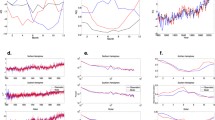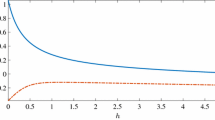Summary
The wastage and accumulation rates of the global ice sheets are taken to be climatic parameters, responding to astronomical forcing, and the global ice volume to be the integral of the difference of these two rates. The particular form of the climatic response function is that it is proportional to the seasonality of irradiance totals. Taking the Fourier series of the ten major periodicities longer than ten millenia in the Berger formulation of the Milankovitch concept as the forcing function, analytical integration yields a time series that correlates about 0.51 with the ice volume reconstruction from oxygen isotopes for the past half million years, and matches the maxima and minima optimally. The integration process resolves part of the previous difficulty of ice volume spectra with too much power in the lowest frequencies.
Zusammenfassung
Die Verlust- und Aufspeicherraten der globalen Eisdecke werden als klimatische Parameter angenommen, welche auf astronomische Einwirkung reagieren und das globale Eisvolumen als das Integral der Differenz dieser beiden Raten. Die spezielle Form der klimatischen Wirkfunktion ist so, daß sie proportional zur jahreszeitlich bedingten gesamten Strahlung ist. Nimmt man die Fourierreihe der zehn wichtigsten Perioden mit länger als zehn Jahrtausenden in der Bergerformulierung des Milankovitchkonzeptes als die bestimmende Funktion an, so ergibt die analytische Integration eine Zeitreihe, welche mit etwa 0,51 mit der Rekonstruktion des Eisvolumens aus den Sauerstoffisotopen der vergangenen halben Million Jahre korreliert und die Maxima und Minima optimal trifft. Das Integrationsverfahren löst Teile der frühen Schwierigkeit bei Eisvolumenspektren, die zu großes Gewicht auf die niedrigsten Frequenzen legten.
Similar content being viewed by others
References
Berger A (1978) Long-term variations of caloric insolation resulting from the earth's orbital elements. Quaternary Res. 9: 139–167
Bryson RA, Baerreis DA, Wendland WM (1967) The character of late-glacial and post-glacial climatic changes. In: Dort W jr, Jones JD (eds) Pleistocene and recent environments of the central plains, Lawrence, University of Kansas Press, pp 53–74, esp. Fig. 14
Hays JD, Imbrie J, Shackleton NJ (1976) Variations in the earth's orbit: pacemaker of the ice ages. Science 194: 1121–1132
Hopkins EJ (1985) Analysis of astronomically-induced monthly and zonally averaged extra-atmospheric irradiance variations for the earth over the last 500,000 years, Ph D thesis, University of Wisconsin-Madison, Dept of Meteorology, p 919
Imbrie J, Hays HD, Martinson DG, McIntyre A, Mix AC, Morley JJ, Pisias NG, Prell WL, Shacklenton NJ (1984) The orbital theory of pleistocene climate: Support from a revised chronology of the marine del18O record”. In: Berger AL et al. (eds), Milankovitch and climate. Pt 1, 269–305, Reidel Publ Co, Dordrecht
Kutzbach JE, Bryson RA, Shen WC (1968) An evaluation of the thermal Rossby number in the pleistocene. Met Monogr 8(30): 134–138
Kutzbach JE, Guetter P (1984) The sensitivity of monsoon climates to orbital parameter changes for 9000 years BP: Experiments with the NCAR general circulation model. In: Berger AL et al. (eds), Milankovitch and climate, Pt 2, 801–820, Reidel Publ Co, Dordrecht
Kutzbach JE, Otto-Bliesner B (1982) The sensitivity of the African-Asian monsoonal climate to orbital parameter changes for 9000 years BP in a lowresolution general circulation model. J Atm Sci 39: 1177–1188
Milankovitch M (1969) Canon of insolation and the ice-age problem (translation from German), Jerusalem, Israel Program for Scientific Translations, p 484
Moran JM (1972) An analysis of periglacial climatic indicators of late glacial time in North America. Ph D thesis, University of Wisconsin-Madison, Dept of Meteorology, p 160
Schneider SH, Londer R (1984) The coevolution of climate and life, San Franciso, Sierra Club Books, p 563
Author information
Authors and Affiliations
Additional information
With 4 Figures
Rights and permissions
About this article
Cite this article
Bryson, R.A., Goodman, B.M. Milankovitch and global ice volume simulation. Theor Appl Climatol 37, 22–28 (1986). https://doi.org/10.1007/BF00866101
Received:
Issue Date:
DOI: https://doi.org/10.1007/BF00866101




